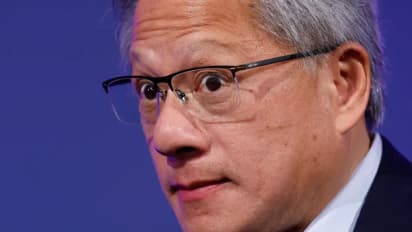Trump Tariffs Weigh On Nvidia Stock, But HSBC Analyst Warns Of Bigger Risks Ahead

Synopsis
HSBC analyst Frank Lee believes Nvidia’s pricing power is weakening, particularly with its new Blackwell B300 and GB300 hardware.
Nvidia’s (NVDA) stock dropped more than 6% in afternoon trade on Thursday, as the ‘Magnificent 7’ sunk lower, tracking toward its largest one-day loss on record.
The broader market sold off after the Trump administration’s tariffs took effect, but Wall Street’s concerns around the AI bellwether go beyond trade policy.
HSBC analyst Frank Lee downgraded Nvidia’s stock to ‘Hold’ from ‘Buy’ and cut his price target to $120 from $175, citing concerns over stagnating growth, as per TheFly.
Lee believes Nvidia’s pricing power is weakening, particularly with its new Blackwell B300 and GB300 hardware, which have not seen a significant price uplift over their predecessors.
Nvidia’s stock is now down 26% from its January 2025 peak, and Lee sees little room for significant earnings upside until new opportunities in robotics, autos, and AI markets emerge.
The analyst noted that Nvidia’s earnings beats have been shrinking for the past three quarters, reflecting increased market scrutiny over its ability to maintain high-margin growth and ongoing uncertainty about the Blackwell supply chain ramp-up.
He also warned of “re-rating headwinds,” meaning investors may not assign the stock a higher valuation multiple, which has been a key driver of Nvidia’s rally since 2023.
Beyond pricing concerns, investors are closely watching developments in China’s AI sector. DeepSeek, a Chinese AI firm, has sparked fears that companies could increasingly train models with lower-cost hardware, which could weigh on long-term demand for Nvidia’s chips.
Additionally, analysts worry that major cloud providers will eventually be forced to cut capital expenditures, potentially curbing Nvidia’s dominant AI-fueled growth.
While tariffs remain a risk, the latest announcement was not as severe as some had feared. The White House confirmed that semiconductor imports would not immediately face the new 32% tariff on Taiwanese goods, where Nvidia’s chips are primarily manufactured.
However, a senior administration official told Barron’s that the semiconductor trade policy is still being evaluated separately.
With total tariffs on Chinese goods now reaching 54%, the possibility of countermeasures could add further uncertainty for Nvidia.
The Trump administration has yet to clarify how it will implement AI chip export restrictions, which will take effect on May 15.
For updates and corrections, email newsroom[at]stocktwits[dot]com.<
Read also: Trump’s Tariffs Spark $1T Tech Sell-Off With The ‘Magnificent 7’ Headed For Their Biggest One-Day Loss On Record
Stay updated with all the latest Business NewsShare Market NewsIPOsGold PriceDA Hike8th Pay CommissionAsianet News Official App